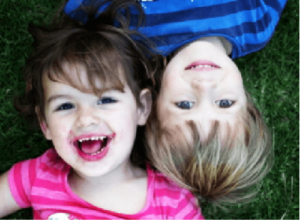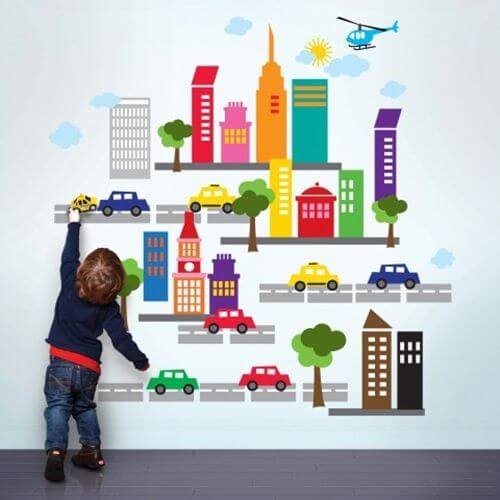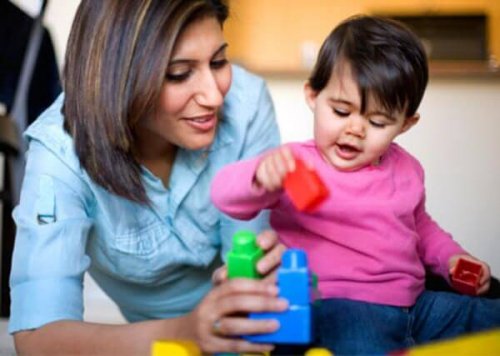Things Your 2-Year-Old Should Know


Written and verified by the doctor Nelton Ramos
Accompanying children in their growth is the most wonderful thing that can happen to us when we’re mothers. Seeing them grow not only in size but also in knowledge and skills is incomparable. However, we always ask ourselves if our child’s developing correctly, if they know what they need to know for their age. Here, we’ll tell you what things your 2-year-old baby should know.
The context: 2-year-olds
We must first put ourselves in the right context. 2-year-olds almost always catch us off guard with their fearlessness, independence, determination, and will, so be prepared! It’s not at all slander when talking about “the terrible 2 years”.
When we hit 2 years old, the giggly and funny babies we had at home become a kind of little monsters who only want more and more independence, who challenge our rules and have tremendous tantrums if they’re not allowed to undertake all their adventures, for they often believe themselves to be more capable than they really are.
So, you have a 2-year-old baby with specific development markers, with few skills, but who are full of enthusiasm and a desire to take on the world. They want to be great, do great things, and they won’t allow anyone to stop them. So, you must grow as a mother and understand that they’ve already earned their own space and begin to allow them to make some of their own decisions, respect the ones they make. If you control the controlling mother in you, you’ll achieve it more easily. It’s time for you to grow as well. So, get ready to discover the things your 2-year-old should know.
Motor skills
Below is a list of motor skills that you’re 2-year-old should have acquired:
- Should be able to walk safely.
- Runs showing dissociation among the arms and legs (doesn’t look like a robot or a block)
- Climb stairs with support.
- Goes downstairs with support (not yet alternating both legs)
- Climbs modules in the park (or on the furniture at home!)
- Can go down a small slide.
- Enjoys the movement of swings.
- Spins on their feet.
- Kicks a ball.
- Throws a ball with their hand.
- Solves matching games with pieces the size of the palm of their hand.
- Can use thick crayons or markers.
- Covers and uncovers markers.
- Paints on large surfaces (60 x 60 cms)
- Tries to put on their shoes.
- Drinks from a glass.
- Tries to eat independently using only a small spoon.
- Puts small pieces in a container and is able to take them out (puts beans in a glass, for example)

Cognitive abilities
- Locates parts of their body (head, belly, legs, nose, hands)
- Imitates actions of daily life such as combing hair, using soap, putting on shoes, using cutlery, talking on the phone, going to “work”
- Recognizes at least 4 animals by name.
- Responds to their name when called.
- Starts learning simple songs and poetry.
- Imitates movements and postures roughly.
- They begin to realize that they have soiled their diapers. In the course of these two years, some already manage to control their sphincters during the day.
- Can count 1,2,3.
Language development
When it comes to language development, there are also things your 2-year-old should know. Take note of the following.
- Increases their vocabulary (they’re constantly saying more words and articulating them better)
- Understands instructions such as sit down, get your shoes, take this to dad, bring your car.
- They say “no” when they don’t want something.
- Uses key words to communicate things like give me, water, tea, mom, dad, etc…
- Imitates the sounds of some animals.
- Calls their family members by name.
- When they’re about to turn 3 years old, they should already be able to express themself fluently in sentences of four or more words.
Social development
- They begin to have “favorite people” that they prefer to be with.
- Has some ritualized games, which they always play. For example, scaring dad.
- Easily learns “thank you” or funny behaviors that they show to others on request, for example, “high five”, “peek-a-boo”, “who’s the princess of the house?”.
- Doesn’t like to share their toys or their “favorite people.”
- Plays alone but enjoys the company of other children by their side.
- Imitates older children, wants to be part of the group of adults.
- Ask for help when they need it.

Some tips to accompany them in their development
- Read stories to them: They’ll listen very carefully and after repeating them, they’ll surprise you by repeating words and scenes from memory.
- Go for walks together: The sun and the fresh air will do you and them a lot of good. In addition, they’ll become familiar with the environment. Running on the safe irregularity of the lawn in the park or on the fine sand of the beach will be enjoyable and will strengthen their limbs.
- Don’t give them too much attention when they seek it through whining and tantrums. However, when they do something that reflects their innate talent in painting, dancing, or singing, applaud them and cheer them on.
- Very important! Give them the opportunity to try different foods, fruits, vegetables, and fun combinations. Inevitably, there will be some flavors they’ll like more and will prefer above all things, but don’t lose heart and offer variety on their plate for them to choose and try.
- Make sure they get enough sleep. From 11 to 14 hours, including naps.
Take these precautions
- We’ve already told you that your baby has gained independence and a certain amount of rebellion. Rather than limit them and always respond negatively to their multiple wishes, make sure that they have a safe area to explore and enjoy.
- Their curiosity will be insatiable, so pick up all hazardous objects and products and move them out of their reach. Block off electrical outlets and be sure to close doors leading to the pool or water fountains. According to the World Health Organization, the highest rates of drowning involve children between 1 and 4 years of age. And overall, drowning is one of the top five causes of death for people ages 1 to 14.
- At the table, make chewing food a game and, of course, put soft and manageable pieces on their plate.
- Be careful with colors and markers. They should be designed for two-year-olds. Remember that, at this age, little ones are still prone to put things in their mouth.
- Keep them away from the oven and boiling or very hot liquids. When you tend to your cooking, do so without your child in your arms. Put them in a safe place first. Everything else can wait.
- In the car, they must travel in the right place and in a suitable car seat. This is non-negotiable. The correct way is to use the seat is facing backward to avoid relative displacements between the head and the chest, in the event of a frontal accident.
Don’t tell them, but they’re still a baby!
This year, your 2-year-old baby will stop being a baby to become a child. It will be a year of great transitions both for them and for you. At the end of these terrible two years, your big baby will be a little boy, so enjoy every moment.
When they’re about to turn 3:
- Your 2-year-old should know to express themself fluently.
- Will have moved from a crib to a bed.
- Will no longer drink milk from a bottle but from a glass with a spout or a straw.
- Will only wear a diaper at night.
- Many begin to take only one nap a day instead of two.
As we said, your baby will soon become a child, so enjoy this stage to the fullest! Also, remember that every child’s unique and develops at their own place. However, if you notice any red flags amount this list of things your 2-year-old should know, don’t hesitate to talk with your doctor.
Accompanying children in their growth is the most wonderful thing that can happen to us when we’re mothers. Seeing them grow not only in size but also in knowledge and skills is incomparable. However, we always ask ourselves if our child’s developing correctly, if they know what they need to know for their age. Here, we’ll tell you what things your 2-year-old baby should know.
The context: 2-year-olds
We must first put ourselves in the right context. 2-year-olds almost always catch us off guard with their fearlessness, independence, determination, and will, so be prepared! It’s not at all slander when talking about “the terrible 2 years”.
When we hit 2 years old, the giggly and funny babies we had at home become a kind of little monsters who only want more and more independence, who challenge our rules and have tremendous tantrums if they’re not allowed to undertake all their adventures, for they often believe themselves to be more capable than they really are.
So, you have a 2-year-old baby with specific development markers, with few skills, but who are full of enthusiasm and a desire to take on the world. They want to be great, do great things, and they won’t allow anyone to stop them. So, you must grow as a mother and understand that they’ve already earned their own space and begin to allow them to make some of their own decisions, respect the ones they make. If you control the controlling mother in you, you’ll achieve it more easily. It’s time for you to grow as well. So, get ready to discover the things your 2-year-old should know.
Motor skills
Below is a list of motor skills that you’re 2-year-old should have acquired:
- Should be able to walk safely.
- Runs showing dissociation among the arms and legs (doesn’t look like a robot or a block)
- Climb stairs with support.
- Goes downstairs with support (not yet alternating both legs)
- Climbs modules in the park (or on the furniture at home!)
- Can go down a small slide.
- Enjoys the movement of swings.
- Spins on their feet.
- Kicks a ball.
- Throws a ball with their hand.
- Solves matching games with pieces the size of the palm of their hand.
- Can use thick crayons or markers.
- Covers and uncovers markers.
- Paints on large surfaces (60 x 60 cms)
- Tries to put on their shoes.
- Drinks from a glass.
- Tries to eat independently using only a small spoon.
- Puts small pieces in a container and is able to take them out (puts beans in a glass, for example)

Cognitive abilities
- Locates parts of their body (head, belly, legs, nose, hands)
- Imitates actions of daily life such as combing hair, using soap, putting on shoes, using cutlery, talking on the phone, going to “work”
- Recognizes at least 4 animals by name.
- Responds to their name when called.
- Starts learning simple songs and poetry.
- Imitates movements and postures roughly.
- They begin to realize that they have soiled their diapers. In the course of these two years, some already manage to control their sphincters during the day.
- Can count 1,2,3.
Language development
When it comes to language development, there are also things your 2-year-old should know. Take note of the following.
- Increases their vocabulary (they’re constantly saying more words and articulating them better)
- Understands instructions such as sit down, get your shoes, take this to dad, bring your car.
- They say “no” when they don’t want something.
- Uses key words to communicate things like give me, water, tea, mom, dad, etc…
- Imitates the sounds of some animals.
- Calls their family members by name.
- When they’re about to turn 3 years old, they should already be able to express themself fluently in sentences of four or more words.
Social development
- They begin to have “favorite people” that they prefer to be with.
- Has some ritualized games, which they always play. For example, scaring dad.
- Easily learns “thank you” or funny behaviors that they show to others on request, for example, “high five”, “peek-a-boo”, “who’s the princess of the house?”.
- Doesn’t like to share their toys or their “favorite people.”
- Plays alone but enjoys the company of other children by their side.
- Imitates older children, wants to be part of the group of adults.
- Ask for help when they need it.

Some tips to accompany them in their development
- Read stories to them: They’ll listen very carefully and after repeating them, they’ll surprise you by repeating words and scenes from memory.
- Go for walks together: The sun and the fresh air will do you and them a lot of good. In addition, they’ll become familiar with the environment. Running on the safe irregularity of the lawn in the park or on the fine sand of the beach will be enjoyable and will strengthen their limbs.
- Don’t give them too much attention when they seek it through whining and tantrums. However, when they do something that reflects their innate talent in painting, dancing, or singing, applaud them and cheer them on.
- Very important! Give them the opportunity to try different foods, fruits, vegetables, and fun combinations. Inevitably, there will be some flavors they’ll like more and will prefer above all things, but don’t lose heart and offer variety on their plate for them to choose and try.
- Make sure they get enough sleep. From 11 to 14 hours, including naps.
Take these precautions
- We’ve already told you that your baby has gained independence and a certain amount of rebellion. Rather than limit them and always respond negatively to their multiple wishes, make sure that they have a safe area to explore and enjoy.
- Their curiosity will be insatiable, so pick up all hazardous objects and products and move them out of their reach. Block off electrical outlets and be sure to close doors leading to the pool or water fountains. According to the World Health Organization, the highest rates of drowning involve children between 1 and 4 years of age. And overall, drowning is one of the top five causes of death for people ages 1 to 14.
- At the table, make chewing food a game and, of course, put soft and manageable pieces on their plate.
- Be careful with colors and markers. They should be designed for two-year-olds. Remember that, at this age, little ones are still prone to put things in their mouth.
- Keep them away from the oven and boiling or very hot liquids. When you tend to your cooking, do so without your child in your arms. Put them in a safe place first. Everything else can wait.
- In the car, they must travel in the right place and in a suitable car seat. This is non-negotiable. The correct way is to use the seat is facing backward to avoid relative displacements between the head and the chest, in the event of a frontal accident.
Don’t tell them, but they’re still a baby!
This year, your 2-year-old baby will stop being a baby to become a child. It will be a year of great transitions both for them and for you. At the end of these terrible two years, your big baby will be a little boy, so enjoy every moment.
When they’re about to turn 3:
- Your 2-year-old should know to express themself fluently.
- Will have moved from a crib to a bed.
- Will no longer drink milk from a bottle but from a glass with a spout or a straw.
- Will only wear a diaper at night.
- Many begin to take only one nap a day instead of two.
As we said, your baby will soon become a child, so enjoy this stage to the fullest! Also, remember that every child’s unique and develops at their own place. However, if you notice any red flags amount this list of things your 2-year-old should know, don’t hesitate to talk with your doctor.
All cited sources were thoroughly reviewed by our team to ensure their quality, reliability, currency, and validity. The bibliography of this article was considered reliable and of academic or scientific accuracy.
- Equipo de Atención Temprana de La Rioja. El niño de 0 a 3 años. Guía de Atención Tempara. https://orientacion.catedu.es/wp-content/uploads/2014/11/Gu%C3%ADa-ni%C3%B1o-0-a-3-a%C3%B1os-La-Rioja.pdf
- Fondo de las Naciones Unidas para la Infancia (UNICEF). La primera infancia importa para cada niño. Septiembre de 2017. https://www.unicef.org/peru/sites/unicef.org.peru/files/2019-01/La_primera_infancia_importa_para_cada_nino_UNICEF.pdf
- Matus, R. I., & Urrutia, J. A. (2017). Aptitud física y habilidades cognitivas. Revista Andaluza de Medicina del Deporte, 10(1), 9-13.
- Sas, O. R., & Estrada, L. C. (2021). Incidencia del uso de pantallas en niñas y niños menores de 2 años. Revista de Psicología, 086-086.
This text is provided for informational purposes only and does not replace consultation with a professional. If in doubt, consult your specialist.








